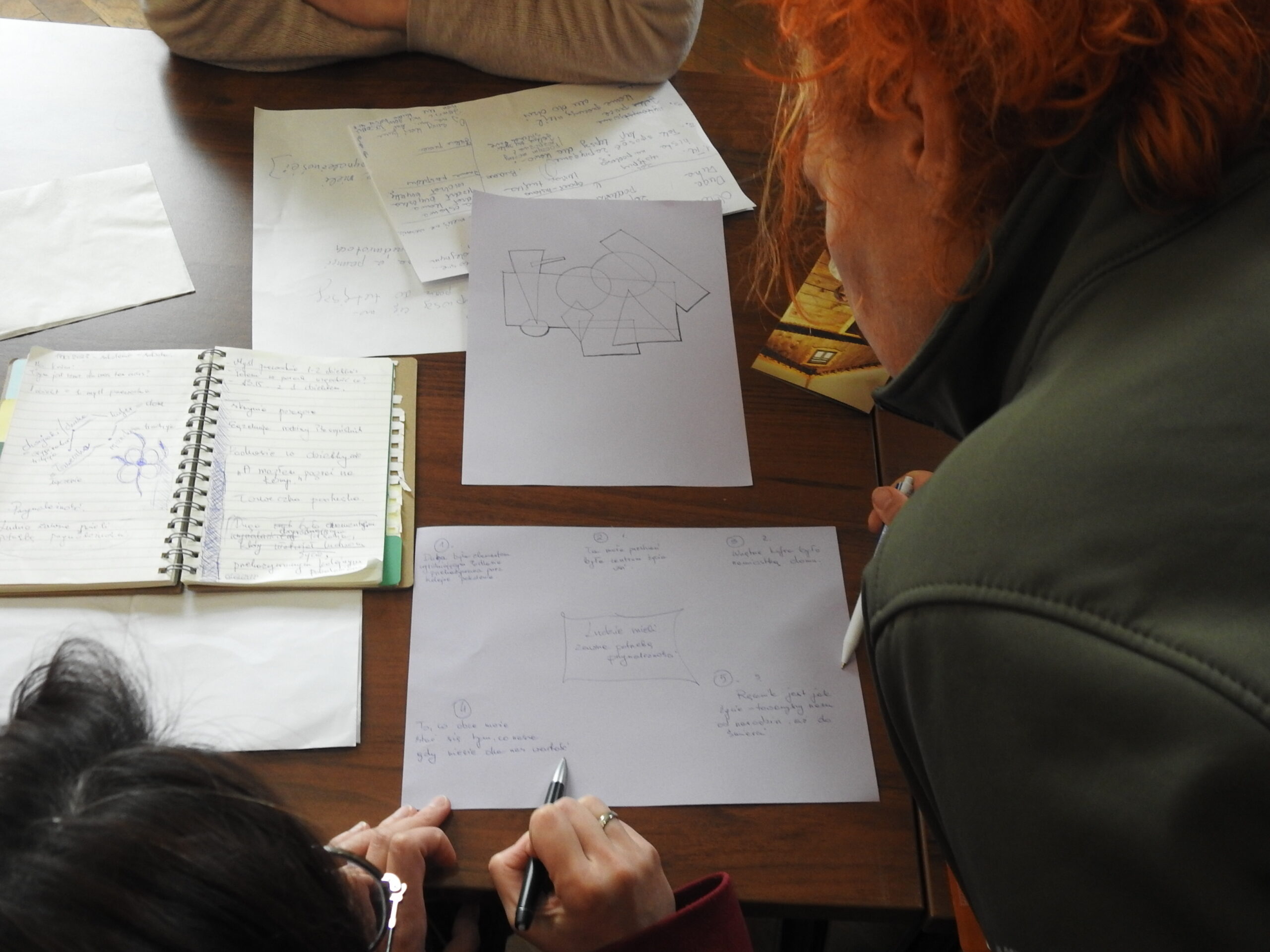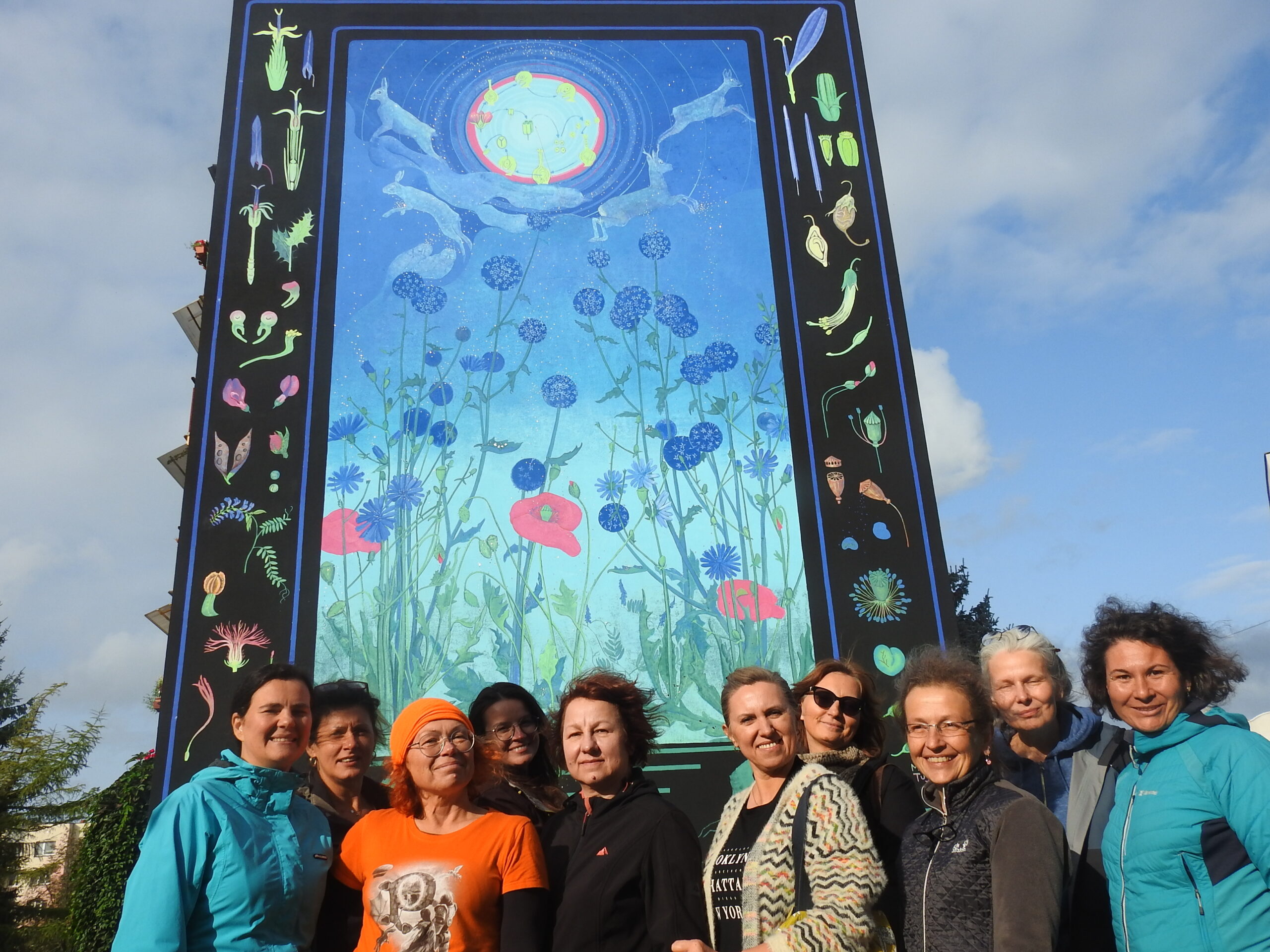If something triggers an emotion in you, you will remember it more easily. If you want to draw someone into a conversation, don’t ask questions that can be answered with “yes” or “no.” Ursula Janiel, one of the participants, talks about what a heritage interpretation course can be useful for.
What prompted you to take the course?
What prompted me? I was intrigued by the heritage interpretation course…
The very name?
Yes, at first the name itself. I didn’t know “what it came with.” I am interested in heritage, both cultural and natural, I used to be a guide in the Białowieża Forest, but due to family obligations I suspended my license. However, the interest remained. Since I signed up for the course, I had mixed feelings all the time, all the time different emotions were hitting me. I constantly had the thought in the back of my mind that I was no longer a guide and that I already had gaps in my memory, that I didn’t have enough knowledge. In turn, the guide kept saying: “Please trust me”, “Don’t give up”. What she was talking about and how she was doing it contrasted with how I was brought up, indeed, probably all of us. It was such a reality that there was a teacher’s monologue during lessons. When there were excursions, it was the guide’s monologue. And that’s still the case today, actually. This course opened my eyes to the fact that it can and even should look different. That interaction with the audience, emotions are very important.
It is important to remember that each person has his or her own experience. The course leader made us realize during the exercises that we do not always receive the message the way the person says it. Our reception can be very different because of our experience, how we perceive certain things….
And we can perceive the message completely contrary to the speaker’s intention?
Yes. The course lasted a total of four days (two weekends) and many hours, and during this time we had various workshops, exercises that showed us that you have to be very careful what you want to convey and this interaction with the other person, appeal to his emotions, evoke positive associations with appropriate symbolism, values, this is really wonderful.

What did the workshop give you? What did you learn?
We learned that place matters less than people. Communicating values and evoking emotions is what modern audiences need. We are attacked with impulses from all sides – TV, Internet, Facebook, Instagram – we are charged with these emotions all the time, but they are on the phone or laptop. What I’ve learned is that with a word or an open-ended question, I’m able to get emotions out of people. Not the guide’s monologue, but asking questions and responding to the answers is what you have to do now. It’s very difficult, it’s a big art, how to convey information, how to ask questions and how to speak to bring out a certain reaction.
I have a feeling that we are talking about the art of communication…
Yes, this is communication. As I mentioned, I’m no longer a tour guide, I’m now in charge of a cultural institution and I organize various exhibitions, give tours and present artists. In this case, my monologue would not be for the 21st century.
So what you learned at the course could be used in your work?
As much as possible. We are used to asking closed questions that can be answered with “yes” or “no.” We learned about a tool that Magdalena Kus – our instructor – called: “listen to your lighthouse”. You have to get to the point and bring about a certain response from people, but at the same time smuggle in factually relevant information related to history, nature, heritage. Developing such an interpretive dialogue is very, very difficult. By asking questions, we will come across someone’s baggage of experience, which he can talk about for hours. The role of the interpreter, on the other hand, is to go and achieve his goal – to ask questions, to play on emotions, but at the same time in the interaction to smuggle in this relevant information, for example, about the history of the region, if historical heritage is mentioned, about culture, if cultural heritage, about nature.
Did you manage to prepare such a mini-walk at the end of the course?
The course ended with each of us conducting an interpretive dialogue. Now we have independent “homework”: by the end of November we are preparing an interpretive walk, which will include a minimum of four interpretive dialogues.
And what kind of dialogue did you prepare?
I prepared an interpretive dialogue on the subject of Podlasie benches. The initial part of the course consisted of theory, with various examples of good practice from the country and the world….

Podlasie bench, or the custom that in villages people sit on benches in front of their houses?
Yes. For every interpretive object you have to choose a motif, and my motif was that this small space was the life of the whole village. That was my slogan. When conducting an interpretive conversation, I asked the viewers what they thought about it, shared my insights, smuggling in relevant facts. Such as, for example, that this bench was once bustling with life. The first question I asked was: “In what place around your house do you like to meet with friends?”. Answers were given: deck chairs, hammocks, terrace. To which I replied: “And they used to meet on benches.” These benches stood along the road, in front of the property. There used to be no deck chairs, hammocks, terraces, because people were in the fields, gardening or taking care of children. And these benches were in front of every property. Later, I asked how we communicated when we wanted to meet on that deck chair or terrace. Answers were given: Messenger, texting. To which I said that in the past there was no Internet, there was at most a radio. This bench was the Internet, television…
And also probably a theater and cabaret in one…
Yes, there were times when people brought instruments and played, sitting on a bench. This is where information was passed, this is where gossip was born. I also added that nowadays it is still cultivated in some places, because those grandmothers in headscarf still go out in front of the house, but they are getting rarer. Much emotion was evoked by my story that my grandfather met my grandmother on such a bench. And this is what heritage interpretation is all about, that we convey information through emotion, so that this object, or my bench, is remembered by the recipient. By the way, history is also remembered, the differences between how things used to be and how they are now. This is how teaching should be done nowadays. Not a monologue, but interaction with the audience. Anything can be interpreted this way, not just heritage. For example, one of the participants chose an orange, by telling her emotions she evoked emotions in others. As I said, this is very difficult. Our emotions were extreme. Starting with: “What am I doing here? I’m not fit” to “Wow, I made it!”.

Good practices regarding interpretive walks?
Yes. There were quite a few of these examples, for example, from various places around the world.
Who in Poland does it well?
For example, the Dyer Workshop, from which our leader is. She showed us various videos of how interpreters work with a group. For example, one of them conducted an interpretive dialogue about wolves. While asking questions, he smuggled in relevant information about these animals. This is an emerging trend in knowledge transfer.
Was this a course for guides?
No, it was a course for the willing. At first I had concerns that I did not have enough knowledge, but it turned out that at any time I could get more information, for example, about a certain tree, read up. After completing the theoretical part, we went to the park for a couple of hours and each of us chose a place for which we had to develop an interpretive dialogue and then present in front of the group. And immediately our mistakes were shown: “Listen, you asked such a question, and you should have asked it this way.” I, for example, at one point turned my back to the people. This was a mistake. I immediately heard what I did right, what came out cool, that people walked around the tree, that they touched a leaf – that was great. They experienced something. You could immediately ask the group about the feelings. “How did you guys feel when Ula asked you that question?”. So we had feedback right away and it was very good. The next weekend we continued the workshop. We learned that we can create a walk from interpretive points. Lead people from point A to B and so on. And we did such a walk at the Museum of Belarusian Culture. Each of us chose an exhibit from the exhibition or an element in the building. And I just chose a Podlasie bench and worked with it.
It’s good that there were both good and bad ones. And not just the bad ones meaning discouragement….
Yes, the whole course is such a game of emotions. It doesn’t matter if you’re a guide, a teacher, a sales lady in a store interpretation can be used at any moment of your life, in any situation. You just have to learn it. And I learned it, I understood what it was all about just on the course. This knowledge is useful everywhere, for example, when dealing with a teenage child who spends time locked in his room with his phone. You can walk up to him and ask a closed question, to which you get a yes or no answer, and no further conversation. And you can ask an open one, which will prompt the teenager to interact. It’s also a bit of learning to be attentive, to be here and now – a skill that is extremely valuable in modern times.
The Heritage Interpretation Course is organized by the Foundation for Development and Educational Initiatives. It is part of the “Guardians of Memory – the art of heritage interpretation” project. The course was held in the first half of October.
